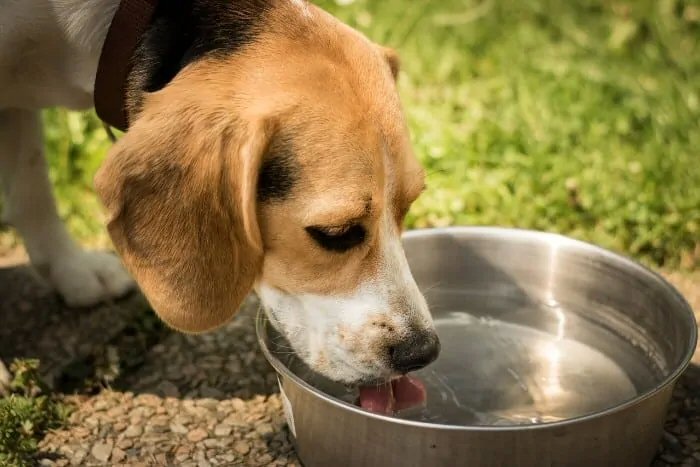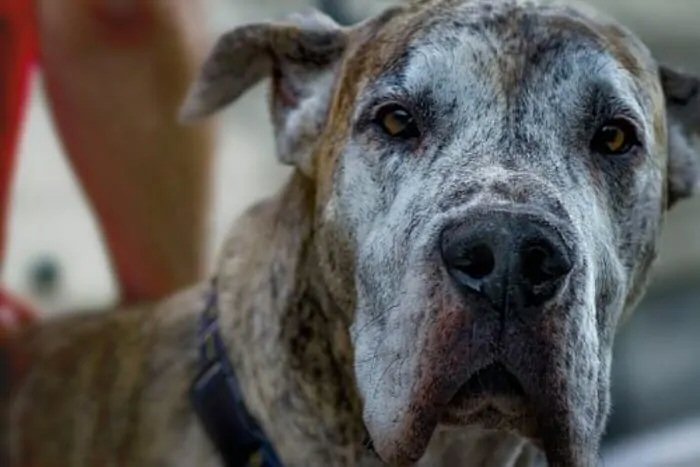|
Co-sponsors of the 2023 Winning Out
Certificates



| |
 Like
all mammals, dogs need to drink water in sufficient amounts to keep their bodies
functioning normally. Water is essential to digestion, circulation and
elimination, and plays an important role in regulating body heat. Without
adequate fluid intake, a dog will become dehydrated and, in time, very sick.
Severe dehydration can even result in death. That said, there are a number of
conditions that may cause a dog to drink more water than usual, and possibly
more than it should. Read on to learn what might be going on. Like
all mammals, dogs need to drink water in sufficient amounts to keep their bodies
functioning normally. Water is essential to digestion, circulation and
elimination, and plays an important role in regulating body heat. Without
adequate fluid intake, a dog will become dehydrated and, in time, very sick.
Severe dehydration can even result in death. That said, there are a number of
conditions that may cause a dog to drink more water than usual, and possibly
more than it should. Read on to learn what might be going on.
Healthy
dogs normally regulate their water intake very well as long as they have plenty
of fresh water to drink. Normally, dogs self-regulate their fluid intake very
well. As long as a dog has a bowl of fresh water available, he will generally
drink enough water to stay hydrated but not enough to cause him harm.
No.1 - Dehydration
Dehydration is fairly common in dogs. It can happen due to
numerous causes, including overheating, vigorous exercise, vomiting and/ or
diarrhea and underlying disease. And while dehydration can be a serious
condition, in dogs who aren't seriously ill, it is generally self-limiting. The
dog's body will detect a drop in blood volume - triggered by too little water-
and secrete hormones that trigger the thirst response. So, as long as the dog
has adequate water available, he will drink enough to replenish the fluids that
have been lost. Depending on how dehydrated the dog was, that can mean he drinks
much more than normal for a while.
To keep
your dog well-hydrated, remember to offer him at least ˝ to one ounce of water per
pound of body weight every day. That's about a cup-and-a-half to three cups of
water daily for a 25 pound dog.) Keep in mind, however, that this is the average amount
of water a healthy dog should drink. If your dog is exercising heavily, or if
the temperature is very high, he will need more.
 Dogs
can get dehydrated if they are outside in the heat for too long. Dogs
can get dehydrated if they are outside in the heat for too long.
Vomiting
and diarrhea also increase the amount of water a dog needs, though he may not be
able to take in adequate quantities if his gastrointestinal issues are severe.
If your dog is vomiting and refusing to drink, contact your vet. She may
recommend an electrolyte replacement drink such as Pedialyte or
fluid replacement via the subcutaneous or intravenous route.
No. 2 - Diabetes
Diabetes is
a condition in which a dog's body fails to make sufficient quantities of the
hormone insulin or when adequate insulin is present, but it can't be properly
utilized (insulin
resistance.)
Insulin is necessary for the proper transfer of glucose — a product of digestion
that is one of the body's main sources of energy — into the cells. When enough
insulin isn't available, too much glucose remains in the bloodstream, a
condition known as hyperglycaemia.
The only
way the dog's body can rid itself of this excess glucose is through the kidneys,
which flush it outpolyuria
along with large amounts of water. This results in excess urination (polyuria)
and, because the dog is trying to replenish lost fluids, excess thirst (polydipsia.)
In many cases, the dog will also be excessively hungry (polyphagia) because the
cells of the body are literally starving despite the fact that the dog is eating
enough. This triad of symptoms is often referred to by medical professionals as
'The Three P's.'
Diabetes
is most common in middle-aged and older dogs, especially those who are overweight
or obese. According
to the American Veterinary Medical Association, the average age of onset it
between 4 and 14 years age, with the majority of diagnoses occurring between 7
and 10 years. In addition to the Three P's mentioned above, a dog with diabetes
may also show other symptoms, such as:
-
Decreased energy
-
Urinary incontinence (for
example, inappropriately urinating indoors or during sleep)
-
Weight loss
-
Cloudy eyes
-
Frequent skin infections
-
Low
appetite (in advanced disease)
 Overweight
dogs are more prone to diabetes than dogs who are normal weight. Overweight
dogs are more prone to diabetes than dogs who are normal weight.
Chronic
hyperglycaemia is an extremely serious condition that can damage internal
organs, including the kidneys, heart, brain and nerves. It can also lead to
cataracts and blindness. If left untreated for too long, high blood sugar can
also bring on a life-threatening condition known as diabetic ketoacidosis (DKA),
which occurs when the dog's body — starved of glucose — begins to break down
fat for fuel. Signs of DKA include panting, tiredness, vomiting and a fruity
odour to the breath.
If you
suspect your dog is suffering from diabetes, take her to the vet as soon as you
can. The vet will draw blood and check her urine, which should quickly determine
if diabetes is the cause of your dog drinking so much. Diabetes is quite
treatable, especially if caught early. Most dogs go on to live long, relatively
healthy lives.
No. 3 - Cushing's Disease
Largely seen in middle-aged and older dogs, Cushing's disease, or
Cushing's syndrome as it is sometimes called, is caused by an excess of the
hormone cortisol in the blood. Produced by the adrenal gland, cortisol is often
referred to as the body's main “stress hormone” because it is produced in higher
quantities when a dog is under some kind of stress. Cortisol plays a very
important role in many bodily functions, including:
-
Glucose, fat and protein metabolism
-
The
'fight or flight' response to threat
-
Blood
pressure regulation
-
The
inflammatory response
-
Regulating sleep and wakefulness
In
healthy dogs, cortisol levels are regulated by a feedback loop between the
pituitary gland — a small pea-sized gland at the base of the brain — and the
adrenal gland. When more cortisol is needed, the pituitary secretes a chemical (adrenocorticotropic
hormone, or ACTH) that signals the adrenals to make more. But when a dog has
Cushing's disease, this feedback loop is disrupted, and the adrenal glands
produce more cortisol than the dog needs.
 Older
dogs tend to suffer from Cushing's disease more often than younger ones.
Symptoms vary, but drinking a lot of water is a common sign. Older
dogs tend to suffer from Cushing's disease more often than younger ones.
Symptoms vary, but drinking a lot of water is a common sign.
Cushing's
disease has two main forms:
-
Pituitary dependent Cushing's disease is
caused by a benign tumour on the pituitary gland that causes the excess
production of ACTH with a resulting increase in circulating cortisol. (This
is the most common.)
-
Adrenal dependent Cushing's disease is caused by a tumour on one or both
of the adrenal glands. These tumours are usually benign but may be
malignant.
Some dogs
may also develop what's called Iatrogenic Cushing's syndrome, which is caused by
the administration of oral or injectable steroids for a long period of time.
In
addition to being very thirsty, dogs with Cushing's disease tend to urinate more
than normal and may be incontinent, especially at night. Other signs of
Cushing's syndrome include:-
Cushing's
disease is usually treatable with either medication of surgery. If you suspect
your dog is suffering from Cushing's disease, make an appointment to have him
evaluated by your vet.
No.4 - Chronic Kidney
Disease
The kidneys are two bean-shaped organs that sit on either side of
the abdominal cavity. One of the most important organs in the body, they are
responsible for filtering toxins and other by-products of metabolism from the
bloodstream and manufacturing urine through which waste products are eliminated.
They also regulate the amount of important minerals called electrolytes in the
body, and help maintain water balance and blood pH.
As dogs
age, their kidneys become less efficient, and some of their filtering capacity
is lost. This is a gradual process, and symptoms don't usually show up until the
problem has been going on for months or even years. According to VCA Animal
Hospitals, the average age of onset of chronic kidney disease in small dogs is
ten to fourteen, but it can occur as early as seven years of age in larger
breeds.
 Large
breed dogs are more likely to suffer from kidney disease at an earlier age. Large
breed dogs are more likely to suffer from kidney disease at an earlier age.
As the
kidneys become less efficient, waste products and toxins build up in the blood.
In an attempt to rid the body of these substances, blood flow to the kidneys is
increased. This forces the kidneys to produce more urine, and, hence the dog
urinates more. To make up for this fluid loss, she drinks more water as well.
These two symptoms — increased urination and increased thirst — are two of the
earliest signs of chronic kidney
failure in
dogs.
Kidney
disease due to aging is generally progressive, but that doesn't mean there's
nothing that can be done to help your dog. Depending on the stage of kidney
failure (that is, how much kidney function has been lost) your vet can put
together a treatment plan that can help your dog live relatively well for many
months or even years. With that being said, the earlier treatment is instituted,
the higher the likelihood of success. So if your dog is drinking too much water
and urinating a great deal, take her to the vet right away.
No.5 - Pyometra
Pyometra is an infection in the uterus in an unspayed, female
dog. It is most common in older dogs who have gone through multiple cycles of
oestrus (heat), but it can also occur in a younger dog. Symptoms usually show up
about one to three months after the dog's last heat.
Pyometra
occurs as a result of a number of factors. Following an estrus cycle, a dog's
ovaries produce increased amounts of the hormone progesterone, which causes the
uterine lining to thicken in preparation for pregnancy. If
the dog doesn't become pregnant, progesterone levels fall off after about two
months, but the thickening in the lining of the uterus remains. After the dog
goes through multiple estrus cycles, the uterine lining may become so thick that
cysts begin to develop in the uterine wall, a condition known as cystic
endometrial hyperplasia.
This thick, cystic uterine lining also secretes fluid, which creates a perfect
environment for harmful bacteria to grow.
 A
dog with pyometra will usually appear quite ill and may or may not have vaginal
discharge. Drinking a great deal of water is another important sign. A
dog with pyometra will usually appear quite ill and may or may not have vaginal
discharge. Drinking a great deal of water is another important sign.
Bacteria
may enter the uterus during oestrus, when the cervix (the opening at the mouth
of the uterus) is open to allow sperm to enter and impregnate the dog. In a dog
with a healthy uterus, this isn't a problem — the normal uterine environment
inhibits bacterial growth. But in a dog with endometrial hyperplasia, those
bacteria can multiply. When this happens, infection ensues, and the uterus fills
with pus. The most common culprit in these infections is the bacteria Escherichia
coli (E.coli).
The
symptoms of pyometra depend on whether the dog's cervix is open or closed.
-
In open
pyometra, the dog will usually have a dark brown or pus-coloured
discharge from her vulva. Fever, poor appetite and listlessness may also
occur.
-
In
dogs with closed pyometra, pus is trapped in the uterus, which will
cause the dog's belly to be distended and hard. Dogs with this condition
will usually refuse to eat, be very listless and appear very ill.
Additionally, if the offending organism is E. coli, the dog may be urinating
more frequently and drinking a lot of water. This occurs because E.coli excretes
a toxin that damages the kidneys, causing urine output to increase. The dog
attempts to compensate for the excess fluid loss by drinking more.
If your
dog is an unspayed female of any age and she suddenly begins to drink a lot of
water, urinate more frequently, and appear unwell, it's important to have her
evaluated by your vet right away. Pyometra is a very serious infection that can
be fatal if the infected uterus isn't removed. But with proper treatment, the
dog can be cured and live a long and healthy life.
No.6 - Medications
Sometimes the cause of excessive thirst in a dog isn't a disease,
but the medicine used to treat a disease. Just as in humans, many medications
can cause a dry mouth or physiologic effects that increase thirst.
Some of
the most common of these include:-
-
Prednisone or prednisolone: These
medicines are steroids which act in the body in much the way cortisol does.
They are typically used to suppress inflammation, such as allergies or
severe arthritis. Steroids can increase thirst and hunger, and in some cases
elevate blood sugar, which may cause the same symptoms as seen in diabetic
dogs.
-
Furosemide (Lasix): Furosemide
is a diuretic that is used to treat congestive heart failure and some forms
of kidney disease in dogs. The purpose of the drug is to remove excess fluid
from body tissues. It acts blocking the reabsorption of water and ceratin
electrolytes in the kidneys, which causes the dog to urinate a great deal,
which, in turn, stimulates thirst.
-
Antihistamines (diphenhydramine (Benadryl); cetirizine (Zyrtec); chlorphenamie)
Antihistamines are often used to treat allergies in dogs. They have various side
effects, including tiredness, lethargy and increased thirst.
Summing Up
Increased thirst is a common occurrence in dogs. Many times, it's
nothing serious. Your dog may just have exercised too vigorously or got a little
dehydrated playing outdoors. But if your dog is drinking a great deal more water
than usual over an extended period of time, there may very well be something
serious going on. And since most illnesses respond best when they are treated
early, it's a good idea to bring your thirsty pooch in for checkup as soon as
you can.
Reprinted
with the kind permission of
Your
Dog Advisor© I (October
17, 2020 by Your
Dog Advisor Staff)
First published 15th February 2021
| |
|